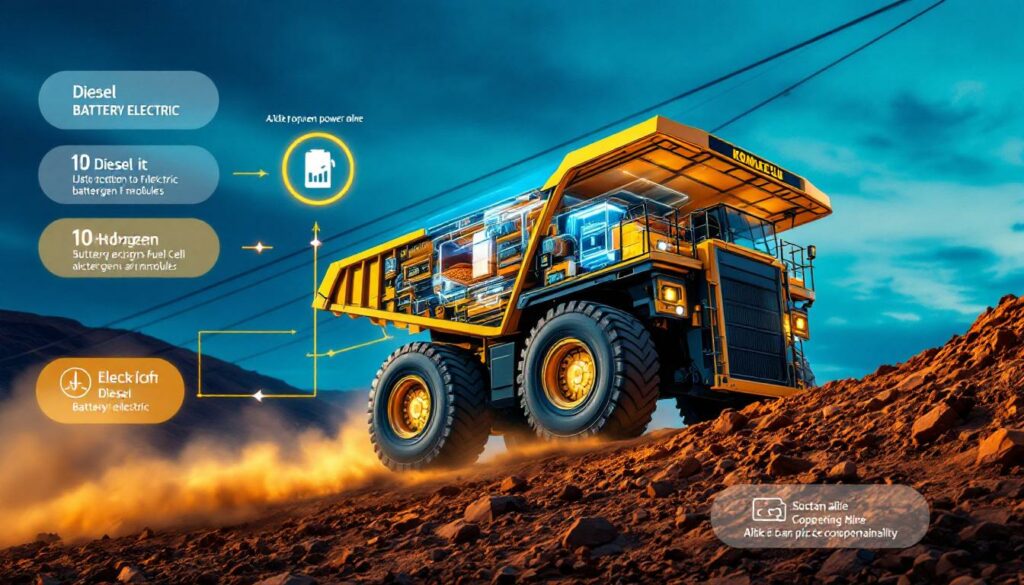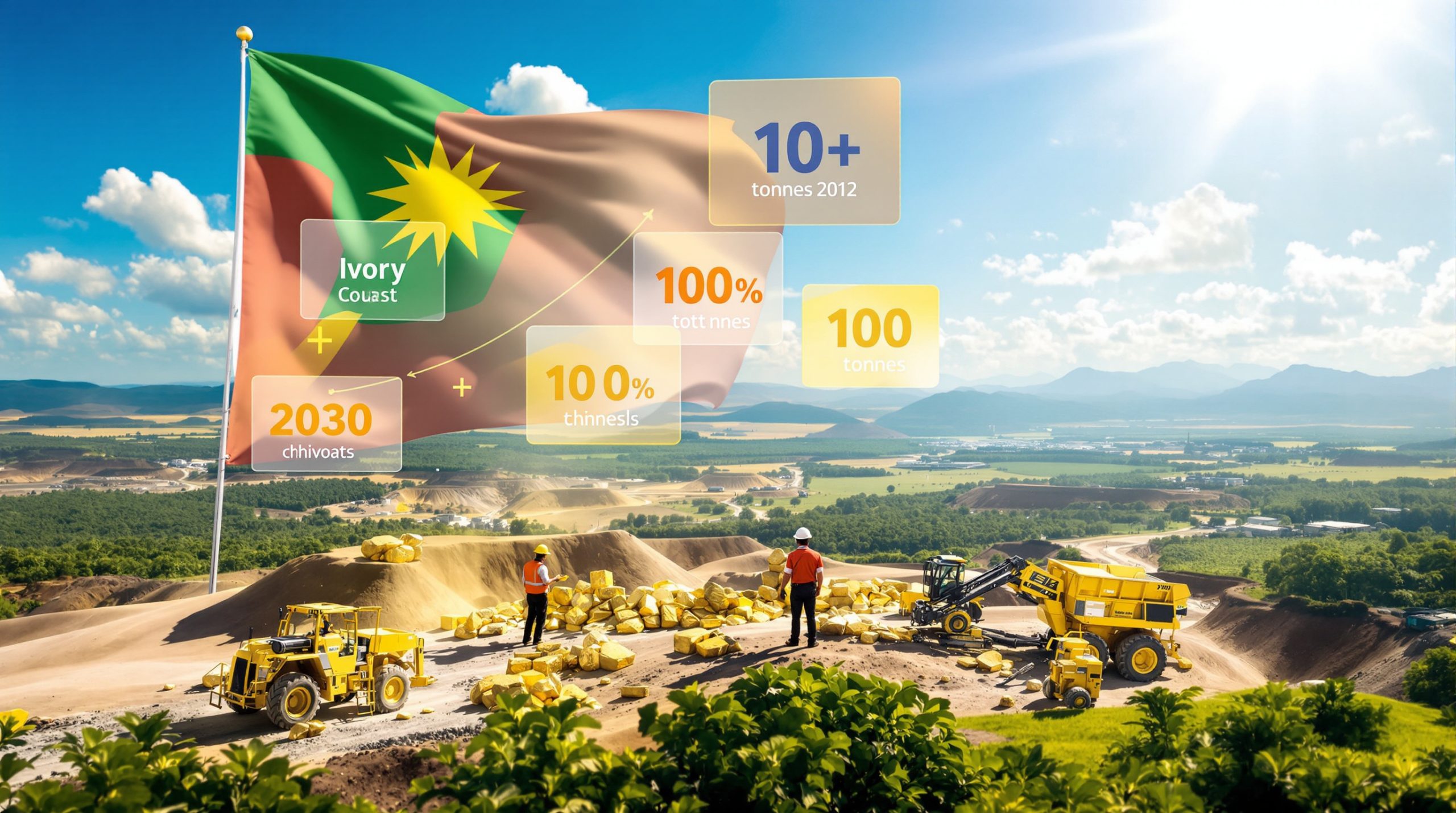What is Komatsu's Power Agnostic Truck Technology?
The Power Agnostic (PA) platform represents a revolutionary approach to mining transportation, designed with modularity and future adaptability at its core. Unveiled at MINExpo 2024 in Las Vegas and first deployed at Boliden's Aitik mine in July 2025, this innovative framework allows mining operations to begin with conventional diesel power while maintaining the flexibility to transition to alternative energy sources as technology evolves.
The modular architecture separates the power generation system from the truck's core operational components, accommodating various power sources including diesel, battery-electric, and hydrogen fuel cell technologies throughout the vehicle's lifespan.
"Integrating the Power Agnostic 930E into our fleet reflects Boliden's ambition to be at the forefront of sustainable mining. Partnering with Komatsu on this pilot helps us explore innovative solutions that align with our climate goals while continuing to deliver productivity and performance." — Jonas Ranggård, Sr. Project Manager, Boliden (Global Mining Review, July 24, 2025)
The diesel trolley system integrated into the PA trucks creates a hybrid power solution that significantly reduces fuel consumption and emissions during operations. By drawing electricity from overhead catenary lines on uphill segments, trucks can operate with reduced diesel engine load, resulting in improved efficiency and environmental performance while maintaining operational capabilities in areas without electrification infrastructure.
This ingenious design allows mining operations to gradually implement cleaner energy technologies without replacing entire fleets, creating a sustainable transition path toward zero-emission mining transportation.
Why is the Komatsu PA 930E Deployment Significant?
Milestone in Mining Decarbonization Efforts
The commissioning of the first diesel trolley Power Agnostic truck represents a pivotal advancement in the mining industry's journey toward carbon reduction. This deployment marks the transition from conceptual design to practical implementation, providing real-world validation of technologies that could fundamentally transform mining transportation systems and their environmental impact.
"This is more than just a technical achievement, it's a meaningful step forward in our joint commitment towards zero-emission mining. By commissioning the first diesel trolley power agnostic truck at Boliden's Aitik Mine, we are turning vision into reality." — Jeroen De Roeck, Senior Mining Manager, Komatsu Europe (Global Mining Review, July 24, 2025)
The significance extends beyond a single truck deployment – it represents a bridge technology that enables mining operations to begin decarbonization immediately while creating a clear pathway toward complete emission elimination as battery and hydrogen technologies mature. The mining decarbonisation benefits of such technologies include reduced operational costs, improved environmental performance, and enhanced social license to operate.
Strategic Partnership with Boliden
The collaboration between Komatsu and Boliden demonstrates how equipment manufacturers and mining operators can work together to accelerate sustainable innovation. As a founding member of Komatsu's Greenhouse Gas Alliance, Boliden's participation in this field trial illustrates the mining industry's growing commitment to environmental stewardship while maintaining operational excellence.
This partnership approach reflects the complex nature of mining decarbonization, which requires alignment between equipment developers, mine operators, infrastructure providers, and energy suppliers to create viable solutions for the industry's challenging operating environments.
Where is the Field Trial Taking Place?
Aitik Mine: Europe's Copper Production Powerhouse
The Aitik mine in Gällivare, Sweden serves as the testing ground for this groundbreaking technology. As one of Europe's largest and most productive open-pit copper operations, Aitik provides an ideal environment to evaluate the PA 930E's performance under demanding real-world conditions.
The mine's existing infrastructure and Boliden's sustainability focus make it particularly suitable for this pioneering field trial. Aitik's operational scale, with its extensive haulage routes and elevation changes, provides the perfect proving ground for testing the diesel-trolley capabilities of the PA platform under various load conditions and operational scenarios.
Trial Parameters and Duration
The comprehensive 12-month field trial has been structured to gather extensive operational data across various mining conditions. This extended testing period will allow engineers to evaluate the truck's performance across seasonal variations, different operational scenarios, and varying load requirements, providing crucial insights for future refinements.
The trial will benchmark the PA 930E against conventional haul trucks operating under similar conditions, measuring key performance indicators including fuel consumption, emissions reduction, maintenance requirements, and operational reliability. These data points will inform both ongoing optimization of the diesel-trolley configuration and development pathways for future battery-electric and hydrogen fuel cell modules.
How Does the Power Agnostic Platform Work?
Modular Design Principles
The PA platform employs a modular architecture that separates the power generation system from the truck's core operational components. This design philosophy allows for the power source to be exchanged or upgraded without requiring a complete vehicle replacement, significantly extending the useful life of the equipment and reducing total ownership costs.
The modularity extends beyond simply swapping power sources – it encompasses the integration of control systems, cooling requirements, and power delivery mechanisms specific to each energy technology. This sophisticated engineering approach allows mining operations to protect their capital investment while progressively adopting cleaner technologies.
Rather than the traditional approach of designing purpose-built vehicles around specific power sources, Komatsu has created a universal platform that accommodates various energy technologies through standardized interfaces and adaptable subsystems.
Transition Pathways to Zero-Emission Mining
The platform creates a structured pathway for mining operations to progressively reduce their carbon footprint. Starting with diesel trolley technology, operations can gradually implement battery-electric or hydrogen-powered trucks as these technologies mature and as site infrastructure develops, without abandoning their initial investment in the vehicle platform.
This pathway recognizes the reality that most mining operations cannot immediately transition to zero-emission equipment due to infrastructure limitations, technology readiness, and capital constraints. The PA platform allows mines to begin their decarbonization journey immediately while maintaining a clear upgrade path aligned with their sustainability timelines and operational requirements.
For mining companies, this flexibility provides unprecedented strategic options – they can accelerate adoption of alternative power modules in response to carbon pricing changes, energy cost fluctuations, or corporate sustainability targets without wholesale fleet replacement.
What Benefits Does the PA 930E Offer Mining Operations?
Environmental Performance Improvements
The diesel trolley configuration of the PA 930E delivers immediate environmental benefits through reduced fuel consumption and lower emissions. While specific figures from the Aitik trial are pending, similar trolley-assist systems in mining operations have demonstrated significant diesel reduction during uphill haulage operations, which typically represent the most energy-intensive phase of mining transportation.
The environmental benefits extend beyond reduced carbon emissions – lower diesel consumption also means reduced particulate matter, nitrogen oxides, and other air pollutants that affect local air quality and worker health. Additionally, reduced engine operation under load can decrease noise pollution throughout the mine site.
As mines face increasing pressure to reduce their environmental footprint from regulators, investors, and communities, the PA platform offers a tangible pathway to demonstrate progressive improvement rather than waiting for perfect zero-emission solutions.
Operational Flexibility and Future-Proofing
The adaptable nature of the PA platform provides mining operations with unprecedented flexibility to adjust their equipment power sources as operational needs evolve. This future-proofing aspect represents a fundamental shift from the traditional equipment replacement cycle, allowing mines to adopt new energy technologies incrementally rather than through complete fleet replacements.
This flexibility extends to operational scenarios as well – the diesel trolley configuration can operate on both electrified and non-electrified haul roads, maintaining productivity during infrastructure development or in areas where overhead lines aren't practical. As battery or hydrogen modules become available, operations can further expand their zero-emission zones while maintaining operational continuity.
The modular approach also creates resilience against technology obsolescence – if better battery chemistries or more efficient hydrogen fuel cells emerge, these can be incorporated into the existing platform rather than requiring new vehicle purchases.
Financial Considerations for Mining Companies
While the initial investment in PA technology may exceed conventional haul trucks, the platform's adaptability creates potential for substantial long-term cost advantages. The ability to upgrade power systems rather than replace entire vehicles, combined with reduced fuel expenses and potential carbon taxation benefits, presents a compelling total cost of ownership proposition.
Mining operations can also better manage capital expenditure timing – rather than large, periodic fleet replacements, they can distribute investments across power module upgrades, potentially aligning with production cycles and cash flow availability. This financial flexibility complements the operational adaptability of the platform.
Additionally, as regulatory environments increasingly incorporate carbon pricing, the progressive emission reductions enabled by the PA platform can translate to direct financial benefits through avoided carbon taxes or access to incentive programs for cleaner technologies.
What Technical Challenges Must Be Overcome?
Integration of Multiple Power Sources
The successful implementation of power-agnostic technology requires sophisticated engineering solutions to manage the integration of different energy systems. Engineers must address challenges related to power management, thermal regulation, and control systems to ensure seamless operation regardless of the energy source employed.
Each power technology brings unique requirements – diesel engines need robust exhaust and cooling systems, battery-electric systems require thermal management and charging interfaces, while hydrogen fuel cells demand specialized storage solutions and water vapor management. The PA platform must accommodate these diverse needs within a standardized framework.
Control system integration presents another significant challenge – creating a unified operator experience and performance profile across different power sources requires sophisticated software algorithms and monitoring systems to optimize each technology's specific characteristics while delivering consistent vehicle behavior.
Infrastructure Requirements for Alternative Power
The transition to fully electric or hydrogen-powered mining transportation will require substantial infrastructure development at mine sites. This includes overhead catenary systems for trolley assist, charging or battery exchange stations for battery-electric vehicles, and hydrogen production, storage, and refueling facilities for fuel cell applications.
These infrastructure investments represent a significant consideration for mining operations evaluating the PA platform. The diesel trolley configuration offers an advantage in this regard – mines can begin with limited trolley infrastructure on key haul segments (typically uphill routes where energy consumption is highest) and progressively expand electrification as benefits are proven.
For future battery-electric implementations, mines must consider power distribution capacity, charging logistics that minimize operational disruption, and potentially renewable energy solutions to maximize environmental benefits. Hydrogen implementations face additional challenges related to fuel production, compression, and safe handling protocols in mining environments.
How Will This Technology Impact the Future of Mining?
Industry-Wide Implications for Sustainability Goals
The development and deployment of power-agnostic mining equipment could accelerate the industry's progress toward carbon reduction targets. By providing a practical transition pathway, this technology addresses one of the most significant challenges in mining decarbonization: the massive capital investment typically required for fleet replacement.
Mining companies face increasing pressure from investors, customers, and regulators to reduce their carbon footprint. Technologies like the PA platform enable tangible progress in the near term while establishing a clear pathway toward comprehensive emissions reduction, helping companies demonstrate meaningful action rather than distant commitments.
The modular approach may also influence equipment procurement strategies throughout the industry, shifting from traditional purchase/replace cycles toward more adaptable platforms that can evolve with technology advances. This could fundamentally change relationships between equipment manufacturers and mining operations toward more continuous collaboration.
Potential for Technology Transfer to Other Applications
The principles and technologies developed for the PA platform have potential applications beyond mining. Similar approaches could be adapted for construction equipment, port operations, and other heavy industrial applications where the transition to zero-emission operations faces similar challenges of infrastructure development and technology maturation.
The modular power source architecture could particularly benefit applications where equipment operates in varied environments with different infrastructure availability – for example, construction equipment that works in both urban areas (where electrification might be available) and remote sites (requiring self-contained power).
As decarbonization pressures extend across industrial sectors, the lessons learned from the PA platform's development and deployment could provide valuable insights for other equipment manufacturers seeking to create transition pathways for their customers.
What Results Are Expected from the Field Trial?
Key Performance Indicators Being Measured
The field trial will evaluate multiple aspects of the PA 930E's performance, including fuel efficiency, emissions reduction, maintenance requirements, and operational reliability. These metrics will be compared against conventional haul trucks operating under similar conditions to quantify the benefits and identify areas for improvement.
Beyond technical performance, the trial will assess operational integration aspects – how seamlessly the truck incorporates into existing fleet management systems, whether operators require specialized training, and what modifications to maintenance protocols might be necessary. These practical considerations are crucial for widespread adoption.
The trial will also evaluate the trolley assist infrastructure interface – connection reliability, transition smoothness between diesel and electric power, and any wear patterns at contact points. These insights will inform future trolley system design and potentially influence industry standards for mine electrification infrastructure.
Data Collection and Analysis Methodology
Advanced telemetry systems installed on the test vehicle will continuously monitor performance parameters and operational conditions. This data will undergo comprehensive analysis to validate design assumptions, identify optimization opportunities, and inform future development of the PA platform.
The 12-month duration allows for seasonal analysis – how ambient temperature, precipitation, and other environmental factors affect performance across different power modes. This temporal dimension is particularly important for mining operations in extreme climates like northern Sweden, where equipment must perform reliably across substantial temperature variations.
Beyond vehicle performance, the trial will assess infrastructure integration, operator acceptance, and maintenance implications. This holistic approach recognizes that successful technology adoption depends not just on technical capabilities but on how seamlessly new equipment integrates into existing operational ecosystems.
FAQs About Komatsu's Power Agnostic Technology
How does the Power Agnostic platform compare to conventional mining trucks?
Unlike traditional mining trucks that are permanently tied to a single power source, the PA platform allows for power system exchanges throughout the vehicle's operational life. This provides unprecedented flexibility while maintaining the reliability and performance standards expected in demanding mining environments.
Conventional trucks typically undergo mid-life rebuilds that focus on engine overhauls and structural components while retaining the same basic technology. In contrast, PA trucks can receive completely new power systems that incorporate technological advances or respond to changing operational requirements without scrapping the entire vehicle.
This approach significantly extends useful equipment life, potentially reducing lifetime equipment costs and material consumption while allowing mines to progressively adopt cleaner technologies without complete fleet replacement cycles.
What is the timeline for commercial availability of different power options?
While the diesel trolley configuration is now entering field trials, battery-electric and hydrogen fuel cell modules are in various stages of development. Commercial availability will depend on field trial results, technology readiness, and market demand, with a phased rollout expected over the next several years.
The diesel trolley configuration, now being tested at Aitik, represents the first commercially available option in the PA series. This configuration serves as both an immediate emissions reduction technology and a bridge toward full electrification, allowing mines to begin their decarbonization journey while infrastructure and zero-emission technologies continue to mature.
Mining operations interested in the PA platform should engage with Komatsu early to develop site-specific implementation roadmaps that align power module availability with their sustainability goals, infrastructure development timelines, and fleet replacement cycles.
How does the trolley assist system reduce emissions?
The trolley assist system allows the truck to draw electricity from overhead lines during uphill haulage, significantly reducing diesel engine load during the most energy-intensive phase of operation. This can reduce fuel consumption by up to 90% during trolley-assisted segments while maintaining or improving productivity.
When connected to the overhead catenary system, the truck's diesel engine either operates at minimal load or can shut down entirely, depending on the configuration. The electric power from the trolley lines drives the truck's electric wheel motors directly, providing the high torque needed for uphill haulage without diesel combustion.
This approach is particularly effective in mining operations, where trucks often follow fixed routes with predictable high-energy segments. By electrifying these specific sections, mines can achieve significant emission reductions without requiring full battery-electric vehicles that might face range or charging limitations.
What infrastructure changes are required at mine sites?
Implementation of the full PA ecosystem requires different infrastructure elements depending on the power sources utilized. Trolley assist requires overhead catenary systems on key haul roads, while battery-electric options may require charging stations or battery swap facilities. Hydrogen fuel cell implementations would need hydrogen production, storage, and refueling infrastructure.
The modular approach allows mines to phase infrastructure development alongside vehicle deployment. A typical progression might begin with trolley lines on main uphill haul roads, followed by charging infrastructure development as battery modules become available, with hydrogen facilities representing a longer-term development for many operations.
Power distribution infrastructure is a critical consideration for electrified options – mines may need to upgrade electrical substations and distribution systems to support trolley lines or high-capacity charging stations. Sites with renewable energy generation potential may also incorporate solar, wind, or other clean energy sources to maximize the environmental benefits of electrified haulage.
Further Exploration
Readers interested in learning more about advancements in sustainable mining equipment can also explore related educational content, such as Komatsu's official announcement which offers additional perspective on this technological development.
The komatsu commissions first diesel trolley power agnostic truck represents a significant innovation in mining transportation, offering a practical pathway toward reducing emissions while maintaining operational performance. As the field trial at Aitik mine progresses, industry observers will gain valuable insights into both the technical performance and practical implementation considerations of this groundbreaking technology.
For mining operations considering their own decarbonization strategies, the PA platform offers a compelling alternative to the traditional binary choice between conventional diesel equipment and waiting for fully mature zero-emission alternatives. This middle path – beginning with hybrid technologies like diesel trolley while maintaining upgrade flexibility – may prove essential in helping the mining industry navigate its challenging energy transition. The electrification of mines and adoption of mining innovation trends like this will be crucial for the industry's sustainable future.
Ready to Spot the Next Mining Technology Revolution?
Stay ahead of transformative mining sector innovations like Komatsu's Power Agnostic technology by exploring Discovery Alert's proprietary Discovery IQ model, which delivers real-time notifications on significant ASX mineral discoveries and technology breakthroughs that could reshape the industry. Visit our discoveries page to understand how early identification of game-changing developments can create substantial investment opportunities.




